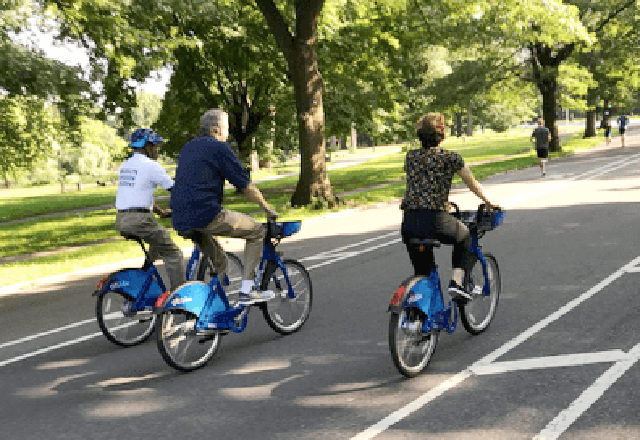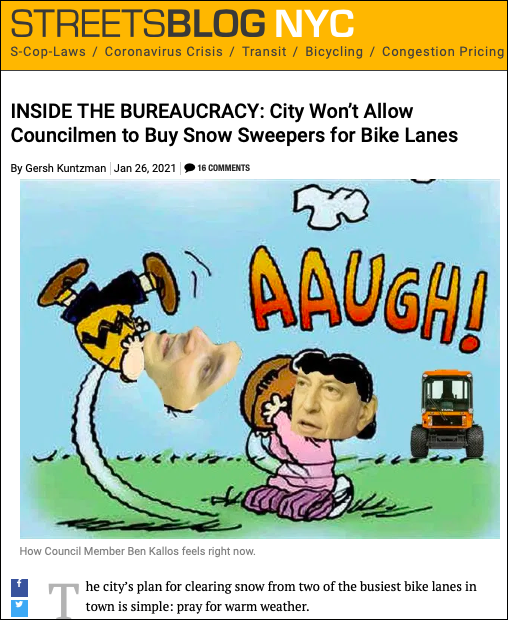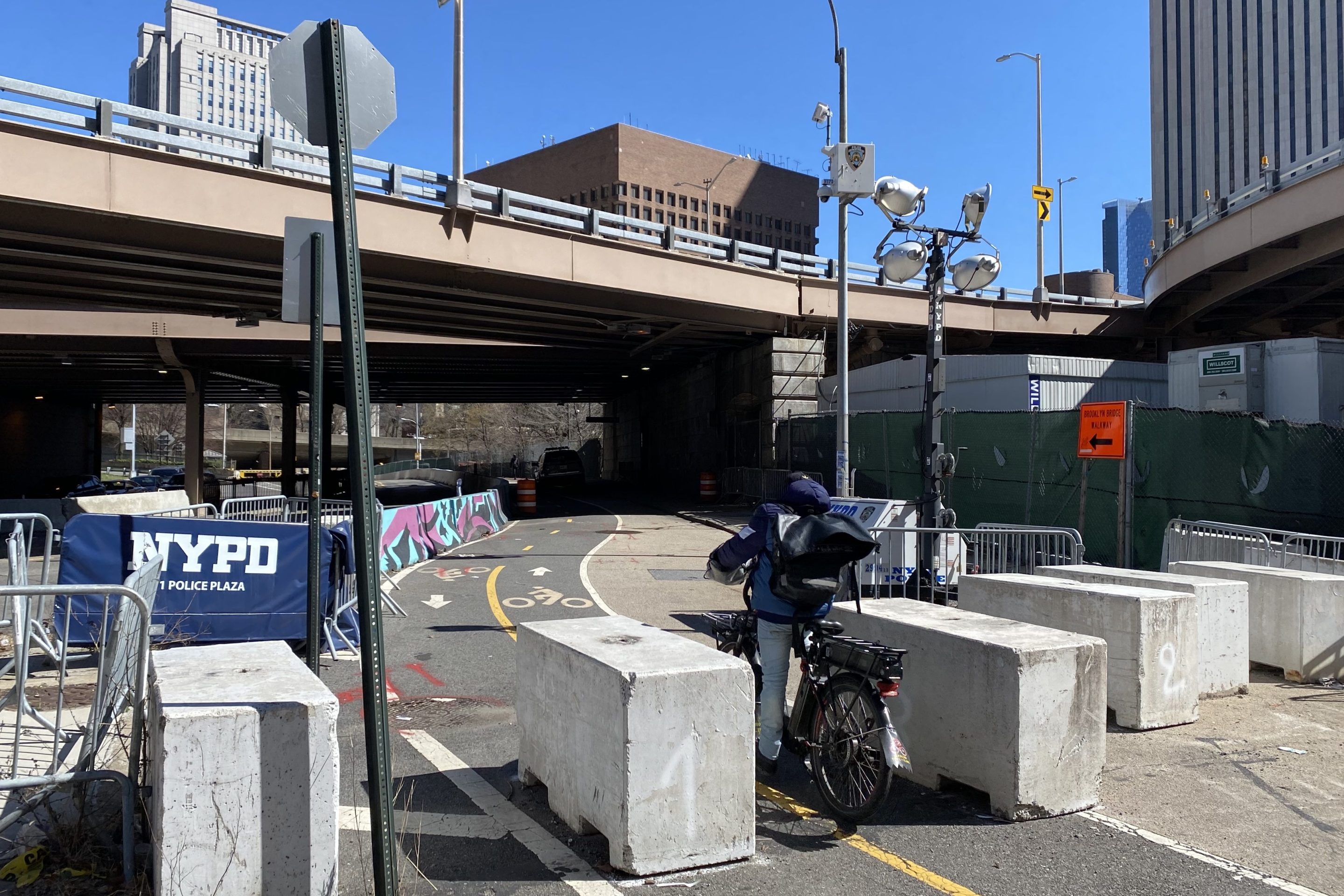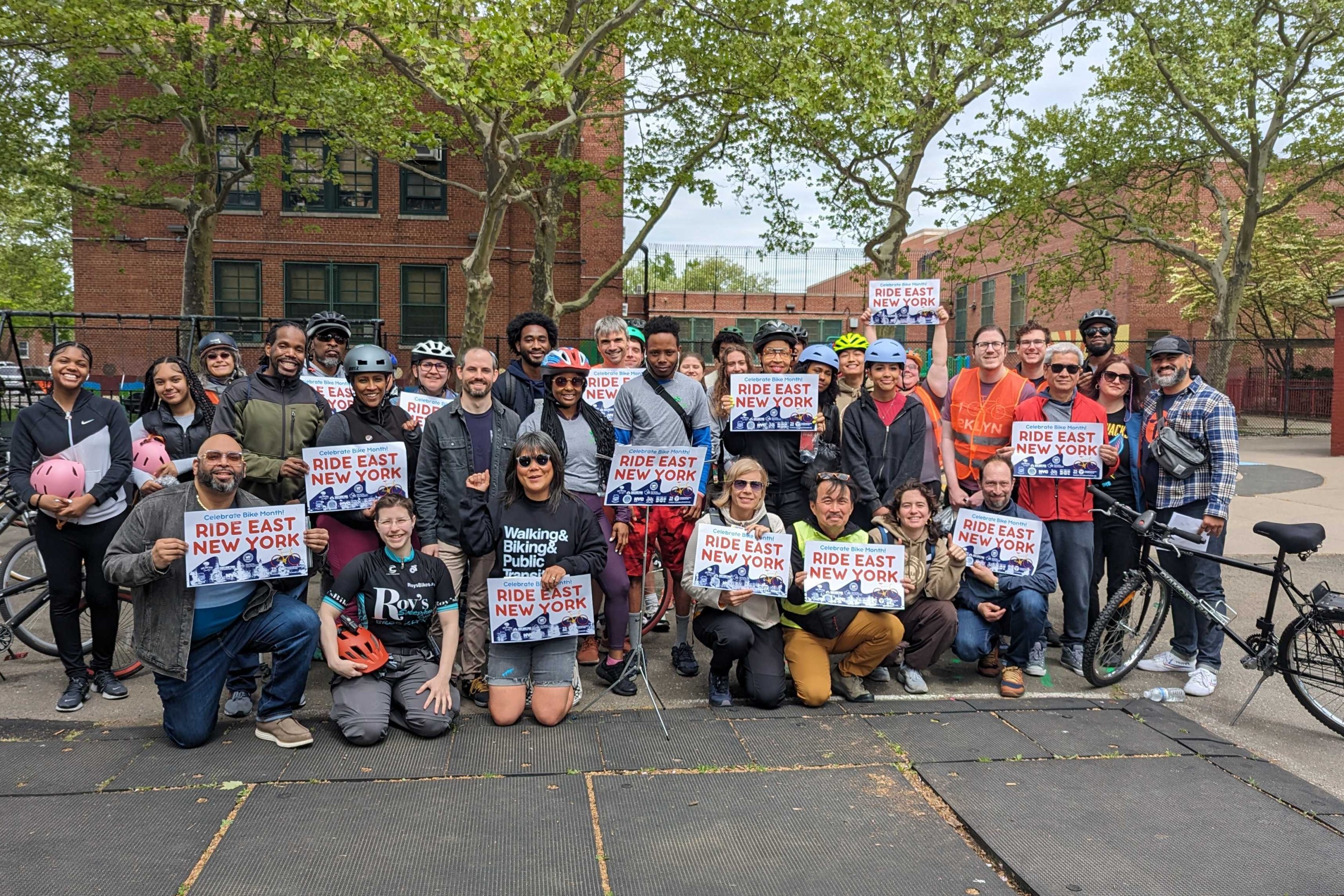ONE YEAR LATER: What Did De Blasio Do After Telling New Yorkers to ‘Bike or Walk to Work’
12:01 AM EST on March 10, 2021

Mayor de Blasio (center), last seen riding a bike in August, 2018. Photo: Natalie Grybauskas
You listened — he didn't.
Exactly one year ago this week, Mayor de Blasio urged New Yorkers to “bike or walk to work if you can” to reduce the spread of the coronavirus, setting in motion a sharp increase in bike commuting, but comparatively little city action to protect those vulnerable road users and strengthen their numbers beyond the pandemic boom, advocates say.

Since that day — March 8, 2020 — at least 215 people died from traffic violence, including more than 25 cyclists and more than 70 pedestrians. One of those victims was 35-year-old Sarah Pitts, who was killed while biking past a notoriously dangerous Brooklyn intersection in September, during the bike boom. Pitts’s brother told Streetsblog that the city failed New Yorkers like his sister, a new cyclist.
“[It’s] so frustrating that with everything that is being done around COVID, and telling people to find other ways to get around, thousands of New Yorkers are putting themselves at risk on the streets on New York,” John Pitts said last year. “It’s a horrifying concept that we shouldn’t accept. There’s a clear mismatch between the importance cycling has taken on, and the city’s ability to make sure people protecting themselves from COVID are also protected while biking.”
Safe-streets advocates and cyclists say emphatically that the mayor did not do enough in the subsequent 365 days after uttering those words.
“There’s certainly more people biking, but, a year later, it feels like the mayor just missed a major opportunity to capitalize on his own advice,” said Doug Gordon, co-host of "The War on Cars" podcast.
Plan to have some extra travel time in your commute. If the train that pulls up is too packed, move to a different car or wait to take the next one.
— Mayor Eric Adams (@NYCMayor) March 8, 2020
Bike or walk to work if you can.
Within days of the mayor’s suggestion, cyclist injuries had jumped 43 percent (compared to the same time period the year before), and the number of injuries kept increasing in places with the worst bike infrastructure, like the Bronx.
De Blasio was slow to act, even as safe-street advocates demanded he urgently build out new, protected bike infrastructure to help handle the surge of new riders — calling on his administration to immediately transform city streets, including by creating a zero tolerance policy on all vehicles blocking bike lanes and bus lanes; build pop-up bike lanes; quickly reconfigure key East River crossings, including dedicated, separated cycling paths on the Brooklyn and Queensboro bridges; and expedite the expansion of Citi Bike in underserved neighborhoods.
Only some of those demands were fulfilled — and those that were were done so insufficiently or tardily, advocates said. Here's a broad overview:
March
On March 25, the mayor announced that a paltry 1.5 miles of roadway would be banned to cars as part of the first iteration of the city's Open Streets initiative — critics at the time said the streets were unnecessarily over policed. The four-roadway experiment intended to get New Yorkers out of their homes for socially distanced recreation throughout the COVID-19 crisis lasted just 11 days. Later iterations of the program were criticized for leaving out neighborhoods that needed it most, and instead catering to wealthier communities already rich with green space.
That same week, the mayor announced the city would install just two new temporary bike lanes on Second Avenue between 43rd and 34th streets and on a four-block stretch of Smith Street between Atlantic Avenue and Fulton Street — but both were initially haphazard.
At the same time, leaders in Bogota created 52 miles of emergency bike lanes to help essential workers.
April
On April 7, de Blasio announced he was cutting $10 million from Vision Zero funding, including $4 million in cuts to spending on street markings and materials spending on Vision Zero Street Improvement Projects, $3 million on spending for Vision Zero public service announcements and another $3 million on building protected bike lanes under the “Green Wave” initiative, plus $8.4 million in savings through June, 2021 for the city's “Better Bus Initiative," which advocates warned at the time would hurt essential workers.
On April 27, under pressure from a City Council demanding action, he committed to 100 miles of open streets — up 25 from the 75 miles of car-free space that the city Council was pushing for. The announcement followed a program that had already been rolled out in Oakland.
Meanwhile in Milan, leaders had announced a plan to create 22 miles of new bike lanes.
May
On May 6, the mayor finally conceded — after push from Streetsblog and other advocates — the importance of transportation as part of his COVID response, creating an advisory panel of transportation experts (though Streetsblog noted at the time that the panel was stacked with more car advocates than bona-fide transportation planners).
On May 12, the city revealed it had not funded the Dangerous Vehicle Abatement Program, an overwhelmingly popular piece of legislation that would require repeat speeding and red light offenders to take a driver-training course or have their wheels seized by the sheriff. The move to block funding for the law came amid a speeding epidemic that was met, more or less, by inaction from cops.
De Blasio's police department said that cops were dealing with other more pressing issues.
"It seems like there may be more speeding — at least in some parts of the city. We don’t condone it. We do enforce it. But we also have other extremely significant pressures on our department," said department spokeswoman Sgt. Mary Frances O’Donnell.
The mayor did nothing to address the increase in speeding, and cyclists took note. One new rider said he started biking last year because at the time it felt safer than the subway, but soon realized it wasn't.
“For people on the streets, driving is the real danger of riding a bike in NYC, sharing the road with these huge hunks of metal that can take you out at any minute, it’s always the biggest fear of biking,” said Timothy Hunter, who works for State Sen. Julia Salazar.
At the same time, Paris was already busy transforming 30 miles of vehicle lanes into bike lanes; in Montreal, Mayor Mayor Valerie Plante announced a plan to create more than 186 miles of temporary pedestrian and bike paths; and in Mexico City, authorities announced plans to create 33 miles of emergency bike lanes.
And in London, Mayor Sadiq Khan announced an ambitious "Streetspace Plan" to increase cycling tenfold by adding 31 miles of protected bike lanes, expanding footways around shops and pedestrianized areas for restaurants and retail, and creating 30 so-called “low-traffic neighborhoods” by closing off some of the streets, including 100 streets around schools at drop-off and pick-up times. Within six months, Khan facilitated what is likely the largest expansion of public space for cyclists and pedestrians and exceeded his own goals by creating 56 miles of cycle lanes, 96 low-traffic neighborhoods (with 35 more proposed), 22,000 square meters of extended sidewalk space, and 305 new school streets. And it ultimately made 53 miles of the city's bus lanes, which only operated during some hours of the day, 24-7.
June
On June 5, the mayor announced the city would expand the successful open streets program to include outdoor dining, to allow struggling eateries to operate in public roadways — again following programs that had already been implemented in other cities like San Francisco, Cincinnati, and Vilnius.
On June 8, the mayor announced he'd create 20 miles of car-free busways and dedicated bus lanes across the city — significantly less than the 60 miles demanded last week by the MTA. (By the end of the year, he created about 16 miles.)
On June 24, de Blasio announced he would install nine more miles of temporary protected bike lanes, including on Northern Boulevard in Queens, Sixth and Seventh avenues in Midtown Manhattan, and Centre/Lafayette from Spring Street to Brooklyn Bridge in Soho. By the end of 2020, DOT said it had built nearly 29 miles of new protected bike lanes, a record (though the agency had already committed to roughly 25 miles of PBLs before the crisis).
One woman told Streetsblog that she actually avoids Northern Boulevard on her commute from Brooklyn to Queens for work — one of the temporary bike lanes the de Blasio administration installed. Riders have complained that the flimsy flexible delineators meant to protect them from speeding cars are routinely crushed and missing.
“I’ve obviously completely avoided Northern Boulevard,” said Sarah, a public librarian, who asked that only her first name be used. "I feel like de Blasio likes to make statements and then there’s no backup. The entire time I’ve been commuting, it’s been a series of cars and police cars parked in the bike lanes."
July
On July 2, the mayor announced far more open streets for restaurants than he initially had promised, revealing that restaurants will be allowed to operate in the roadway of 22 streets — more than the 10-20 roads he had previously promised.
September
On Sept. 1, members of the mayor’s own COVID-19 transportation recovery panel penned an open letter warning about a post-pandemic "carmageddon" if his administration failed to adopt its urgent recommendations, including a “connected and protected network of bike and bus infrastructure.”
“While we acknowledge that the city has taken some steps to address these enormous challenges, we believe that more must be done immediately to avoid the impending wave of congestion, pollution, inequality, and traffic violence,” the panel wrote in its missive.
One member of the panel told Streetsblog this week that nothing ever came of that letter, nor of the panel at all, calling it a "waste of time."
“I don’t really feel the city administration did much in terms of helping cyclists feel any safer. I remember the directive and just remember there was no follow-up,” said Courtney Williams, who runs her own cycling consulting firm, Brown Bike Girl, and who held her own virtual classes to help new riders at the start of the pandemic.
October
On Oct. 23, the mayor admitted that the Department of Transportation wouldn't meet its own target of installing 20 miles of dedicated bus lanes and car-free busways by the end of 2020, after two times in as many weeks, fed-up straphangers asked the mayor about the busways he promised back in June.
"We wanted to do 20 miles by the end of the year. It looks like it’ll be closer to 17, which is a good achievement,” de Blasio said at the time.
Among the concessions was a promised busway on Fifth Avenue from 57th to 34th streets; and months after it was slated to go into effect, the city finally kicked off the Main Street busway.
November
In November, as local community boards were still discussing already announced initiatives, Streetsblog spoke with London's Walking & Cycling Commissioner Will Norman about that city's ambitious and successful Streetspace Plan that far exceeded its own goals, and about his advice for New York.
December

In December, the acting commissioner of the Department of Sanitation admitted that he lacks the right equipment to adequately plow bike lanes filled with snow, after a mid-December storm that left paths dangerously blocked days later.
“We will get there,” said Edward Grayson. “To be able to give a really good bicyclist experience in the first 12 or 24 hours of a storm will take a hell of a lot. I’m not saying it can’t be done, but it would take all kinds of resource allocation. I am ill-equipped to do it in real time.”
Streetsblog's reporting later revealed that the agency has not bought a single narrow snowplow since the 2014 winter, even as the de Blasio administration began its push to build more than 100 miles of protected bike lanes. Even as that effort was underway, the administration hid behind a comptroller's directive that barred it from using capital money to buy newer, more nimble Multihog machines to clear bike lanes — even when members of the Council sought to put up the money.
Statistics show that winter cycling numbers don't go down nearly as much as many people believe — but they plummet in the immediate aftermath of winter storms ... when the mayor has said he doesn't want people driving, yet doesn't do anything to clear the roads for other modes.
Data on how lack of 🚲 lane snow removal suppresses #bikenyc:
— Bike New York (@bikenewyork) February 17, 2021
Daily numbers for the Kent Avenue bike lane in Brooklyn. You can see bike volumes were in the 1,500-2,000 range in the 1st half of the month, but don’t rebound higher than 1,000 until 5 days after the storm https://t.co/ZbPZ8yYC8F pic.twitter.com/0uFoyIGdzD
January
On Jan. 28, 2021, the mayor announced during his state of the city address that he would create so-called bike boulevards in every borough. Hizzoner described the “boulevards” as “streets that are designed to give bicycles travel priority and put cyclist safety first."
"These boulevards will have unique design elements to slow vehicle speeds and reduce volume with traffic diverters, signal timing changes, shared streets, open streets and gateway treatments,” he added. But it still remains unclear what exactly they would look like — or, indeed, when they'll be built.
At the same time, de Blasio also made the bombshell announcement that the city would add a lane for cyclists on both the Brooklyn and Queensboro bridges — one of the most significant repurposing of space from drivers to cyclists in his entire seven-year tenure. But the Brooklyn Bridge lane won't be done until the end of 2021; and the Queensboro Bridge lane is punted off to 2022.
Bike New York’s Jon Orcutt believes that the biggest transformational change yet to come to the city’s infrastructure — which is still just a promise, not an actuality — is thanks to New Yorkers themselves, who all but forced DOT to finally give cyclists more space on the bridge after people started biking in record numbers.
“I think we would not have seen the bridge's announcement in January without the big increase in biking,” said Orcutt. “I think the positive things we’ve seen were mostly coming from New Yorkers themselves, using Citi Bike in record numbers, then the council responding to people and mandating open streets, basically rolling over the mayor on that issue, and then the private sector taking advantage of open dining. I really think the bridges announcement was the best thing.”
Williams agreed that in the year since de Blasio told New Yorkers to bike, he did not do enough.
“It’s largely been a disappointment. The last big announcement about the Brooklyn Bridge bike lane — that came 10 months later," she said.
And not only did the mayor fail physically, he failed symbolically, too. Since that day last year, the mayor never hopped on a bike himself. Streetsblog reported at the time that the mayor said was not ready to take his own advice because his road skills need “work” — though a mayoral spokeswoman later claimed Hizzoner was only joking.
The mayor should have led by example, just like leaders in other cities did, such as Paris Mayor Anne Hidalgo, said Orcutt, referencing former Mayor Bloomberg who famously took the subway just like everyone else.
“The mayor dismisses symbolism, but I think it mattered that Bloomberg took the subway. Of course, you should do that,” he said. (The mayor has taken the subway a couple of times since Streetsblog issued its famous challenge in September.)
But New York just didn’t even try to compete with other cities around the world, where leaders like Hidalgo embraced the cycling boom and built out expansive safe bike networks for riders, specifically making permanent the new 30 miles of bike lanes, said Gordon.
“There wasn’t a massive network of pop-up bike lanes. There isn't a cohesive network that would get an essential worker from the middle of Queens to a hospital in Manhattan,” he said. "When I compare it to Paris, Milan, London it just feels like we wasted a historic opportunity."
But advocates are now looking to the future, and to the next mayor to do more to transform the city's streetscape, specifically calling on all the mayoral candidates to commit to reimagining at least 25 percent of the space currently allocated for vehicles — including 19,000 miles of travel lanes and three million on-street parking spaces — as public space within four years to create a healthier New York that puts people above cars.
"The last year has made it clear that we need a new approach to our streets — one that views them as an asset for our recovery and addresses long standing inequities," said Danny Harris, the executive director of Transportation Alternatives, which launched its new vision called “NYC 25 by 25." "We've challenged our next leaders to move away from one-off projects and endless studies to focus on scaling our success in street redesign to every corner of NYC.”
The DOT disagreed. Here is the agency's full statement:
In 2020, we built a record of nearly 29 miles of new protected bike lanes across all five boroughs, along with 36 miles of conventional bike lanes, in spite of a shorter implementation season, as we saw the significant shift to more cycling during the pandemic. We are continuing to grow our bike network this year to make sure cycling remains a key component of the city's recovery, with 2021 projects to include new dedicated cycling space on the Brooklyn and Queensboro bridges, and new bike boulevards. The city has also pledged to install 10,000 new bike parking racks by the end of 2022.
Julianne Cuba joined Streetsblog in February, 2019, after three years covering local news and politics at The Brooklyn Paper. There, she also covered the notoriously reckless private carting industry and hit-and-runs. A 2015 graduate of Stony Brook University’s School of Journalism Master’s Program, she lives in Brooklyn. Julianne is on Twitter at @julcuba. Email Julianne at julianne@streetsblog.org
Read More:
Stay in touch
Sign up for our free newsletter
More from Streetsblog New York City
City Considers Fixes for Another Ridiculously Slow Cross-Bronx Bus
Potential bus improvements are on the table for the Bronx's Tremont Avenue, but the Adams administration's failures on nearby Fordham Road loom large.
DOT Unveils First Step for Park Row Redesign
The city hopes to make Park Row more appealing to residents and visitors. But the real work is years off.
Monday’s Headlines: East New York’s New Bikes Lanes Reduced Crashes Edition
Initial results show East New York's protected bike lanes made Cozine and Wortman avenues safer. Plus more news.
Stockholm Leader’s Message to NYC: ‘Congestion Pricing Just Works’
"In Stockholm, people really thought that congestion pricing would be the end of the world, the city will come to a standstill, no one would be able to get to work anymore and all the theaters and shops would just go bankrupt. None of that happened."
Friday’s Headlines: Trump Trial Trumps Safety Edition
Is anyone going to bother to fix the dangerous mess on the streets and plazas around the Trump trial? Plus more news.




